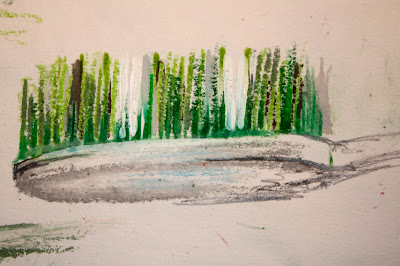The Pop-Up place could describe a particular environment e.g. a garden shed - tools, deckchairs, lawnmower, or a particular sequence; objects that had connections be it through family history, story telling, jokes, secrets etc. I had to consider the space on my desk and how I laid out my objects for others to see.
I considered: colour, contrast, juxtaposition, narratives, texture, form and mood.
For my collection I chose medical history. As my parents work with teeth I decided I could get my hands on a lot of different tools and exciting implements. I collected teeth (real but not my own), molds of impressions, toothpaste, toothbrushes, antiseptic cream, plasters, pills, gauze, surgical masks, first aid kit etc, thus contrasting man-made items against natural bones.

This collection then acted as an image bank for future development. Over the next two weeks I analysed my objects drawing them with different media and in different styles. Visiting the Rachel Whiteread exhibition at the Tate I made note of how she presented her collection of objects, 'Vitrine' and laid out my collection in a similar way, as if the objects belonged in a gallery on display.
Taking into consideration, colour, texture, size, compositions and materials I produced a series of drawings that I could interpret into knit and stitch.(not the greatest quality I know!)
So.. bring on the KNIT!
TECHNICAL BLOCK 1: KNIT
Knitting is a continuous, interlinked, colourful, fuzzy pleasure of a technique - in other words - It's great! I loved seeing one piece of yarn intertwine through looping, dropping stitches, laceholes, cabling, fringing, (the list goes on), allowing it to take on a new form, new shape. We had to incorporate the colours of our drawings and transform them into colourful knitted samples. I have to say it wasn't exactly easy to begin with, I repeatedly dropped stitches creating holes (intentional), ran off my whole knit by just knitting left to right (wish I could say it was intentional) and then there was the challenge that was casting off. As the week went on I improved greatly and soon found casting off easy allowing me to make samples that would not unravel! I enjoyed learning and testing out new stitch patterns with my transfer tool and as knit was new to me I found it a challenge and so was more determined to succeed.
I don't that my samples are anything special as they are quite basic in appearance, however I thoroughly enjoyed observing the 2nd and 3rd year students and seeing where knit could expand - starching samples with sugar and creating intricate sculptural fashion pieces - wow. Knit definitely gave me something to think about and gave me a thirst to learn. If I don't choose it as my specialism I may have to purchase a knit machine anyway. I can definitely see the buzz of those Knitta-please types who go around wrapping knitted cosies around lampposts and railings because it truly is addictive!
e wrapping - loops
lace holes
fringing
punchcard pattern
TECHNICAL BLOCK 2: STITCH
I didn't really know what to expect when I began stitch as it's not like anything I've done before. It is extremely broad and diverse; there are no boundaries or rules therefore you can literally use any medium in which you can get your hands on! After visiting Shepherd's Bush market to buy supplies I began analysing my drawings and seeing how I could translate them using different materials. From rubber and latex, to bondaweb and angel hair fibres, plastic, metal and wood; there is no limit to to what can or cannot be used. I used a large variety of multi-coloured yarns and threads and used many processes such as ironing, sewing, heatpressing or tufting to seal or combine my materials.
At first I found it quite difficult to interpret my drawings without making things appear too crafty or child-like, however once I got into it, I found I really enjoyed the experimental nature of stitch. Stitch involves making many mini maquettes in order to find out what works and what doesn't. It's really hands-on which I loved and as everyone's work is different, I felt you could bounce of other people's ideas allowing you to illustrate your drawings in the best possible way. There is a strong element of design and composition allowing me to use my drawing skills to create detailed, intricate pieces. I found it interesting to test myself with new processes, creating brand new techniques and layers in each sample. Stitch is really about thinking outside of the box, using unconventional methods and materials in order to make something extremely innovative. I also feel that stitch lends itself well to print and so would like to try and combine the two if I could.
Samples:
With this sample I filled plastic tubing with multiple threads, yarns and thin strips of fabric and placed them under the heatpress to flatten and seal the pieces together.
In the above sample I sandwiched together millions of pieces of yarn of differing colour between two layers of bondaweb and ironed them flat. I then coloured my new material with heat transfer paper and began to stitch lines in varying colour all over. After this I cut my piece into many small strips and sandwiched them between more bondaweb, ironing it until it became plasticy in appearance. i then used scissors to unpick bits from under the top layer to reveal the teethy, bristly texture in my toothbrush drawings.
I definitely enjoyed these two blocks and now realise the difficulty I am going to have when choosing my specialism!



































No comments:
Post a Comment